
The Appomattox Court House National Historical Park is a preserved 19th century village in Appomattox County, Virginia. The village is famous for the site of the Battle of Appomattox Court House and contains the house of Wilmer McLean, where the surrender of the Army of Northern Virginia under Robert E. Lee to Union commander Ulysses S. Grant took place on April 9, 1865, effectively ending the American Civil War. The McLean House was the site of the surrender conference, but the village itself is named for the presence nearby of what is now preserved as the Old Appomattox Court House.

The White House of the Confederacy is a historic house located in the Court End neighborhood of Richmond, Virginia. Built in 1818, it was the main executive residence of the sole President of the Confederate States of America, Jefferson Davis, from August 1861 until April 1865. It was viewed as the Confederate States counterpart to the White House in Washington, D.C.

Westover Plantation is a historic colonial tidewater plantation located on the north bank of the James River in Charles City County, Virginia. Established in c. 1730–1750, it is the homestead of the Byrd family of Virginia. State Route 5, a scenic byway, runs east–west to the north of the plantation, connecting the independent cities of Richmond and Williamsburg.
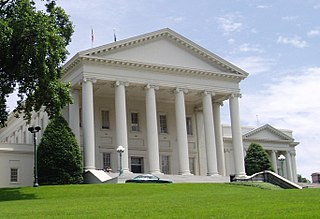
The Virginia State Capitol is the seat of state government of the Commonwealth of Virginia, located in Richmond, the third capital city of the U.S. state of Virginia. It houses the oldest elected legislative body in North America, the Virginia General Assembly, first established as the House of Burgesses in 1619.
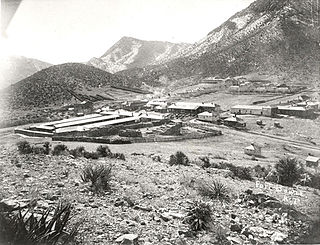
Fort Bowie was a 19th-century outpost of the United States Army located in southeastern Arizona near the present day town of Willcox, Arizona. The remaining buildings and site are now protected as Fort Bowie National Historic Site.
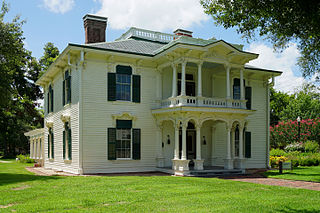
The Sam Bell Maxey House is a historic house in Paris, Lamar County, Texas. Samuel Bell Maxey, a prominent local attorney and later two-term U.S. senator, built the large two-story house after serving as a major general in the Confederate Army. It is built in the High Victorian Italianate style.

The Umpqua River Light is a lighthouse on the Oregon Coast of the United States, located at the mouth of the Umpqua River on Winchester Bay, in Douglas County, Oregon.

The Tarrant County Courthouse is part of the Tarrant County government campus in Fort Worth, Texas, United States.

The Robert Toombs House State Historic Site is a historic property located at 216 East Robert Toombs Avenue in Washington, Georgia. It was the home of Robert Toombs (1810–85), who was a pro-Union U.S. representative and U.S. senator, and then a Confederate general and secretary of state during the American Civil War. Operated as a state historic site, the 19th-century period historic house museum also features exhibits about the life of Toombs. The house was declared a National Historic Landmark in 1973.

The Confederate Monument in Lawrenceburg, Kentucky is an 8-foot-tall (2.4 m) carved granite figure on a granite pedestal which was built in 1894 by the Kentucky Women's Monumental Association, a predecessor of the United Daughters of the Confederacy, an organization founded in that year. Its governing body is the government of Lawrenceburg.
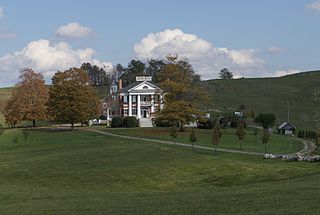
Elmwood, also known as the Hugh Caperton House, is a historic home located near Union, Monroe County, West Virginia. It was built in the 1830s, and is a two-story, nearly square brick dwelling with Greek Revival details. The front facade features wide limestone steps and a veranda, with second-story balcony, Chinese Chippendale railings at both levels, and four plain but huge plaster covered brick columns. The house was built by Congressman Hugh Caperton (1781–1847). It was home to Allen T. Caperton (1810–1876), the first ex-Confederate elected to the United States Senate after the American Civil War.
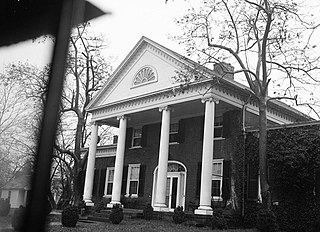
Brompton, originally known as Marye House, is an historic house located on heights overlooking the town of Fredericksburg, Virginia. The house was built in 1838 by John Lawrence Marye. The house was added to the National Register of Historic Places in July 1979.

The Hugh Wilson Hill House, also known as the Kelly-Stone-Hill House, is a historic house in Carrollton, Pickens County, Alabama. It is one of only a few surviving antebellum structures remaining in the town. Architectural historians believe that the one-story Greek Revival-style house was built for Isham and Elizabeth Kelly during the late 1830s or 1840s. Confederate general John Herbert Kelly grew up in the house. It was added to the National Register of Historic Places on April 13, 1989. It was listed as one of Alabama's "Places in Peril" for 2010 by the Alabama Historical Commission and Alabama Trust for Historic Preservation.

Libby Hill is a small neighborhood in Richmond, Virginia. Libby Hill is located on the southeastern spur of Church Hill, overlooking the James River and the Lucky Strike building. It is known for Libby Hill Park and "The View that Named Richmond". The Libby Hill neighborhood is entirely within the St. John's Church Historic District.

The First Battle of Newtonia Historic District, near Newtonia, Missouri, is a National Register of Historic Places (NRHP) site that preserves the location of the First Battle of Newtonia, an 1862 battle during the American Civil War. The battle saw Confederate troops under Colonels Douglas H. Cooper and Joseph O. Shelby defeat a Union force commanded by Brigadier General Frederick C. Salomon. The historic district contains some Civil War-period structures, as well as the Mathew H. Ritchey House, which is listed separately on the NRHP.

The Peter Conser House, in or near Heavener, Oklahoma and/or Hodgen, Oklahoma, was built in 1894 and was the home of Peter Conser from then until his death in 1934. It was listed on the National Register of Historic Places in 1971.

The James E. Reynolds House, located east of Cameron off State Highway 112 in Le Flore County, Oklahoma is a castle which was built in 1911. Also known as Reynolds Castle, it was listed on the National Register of Historic Places in 1977.

The Hunt-Moore House is a historic house in Huntland, Tennessee, U.S..

The Trotter-Byrd House is a historic two-story house in Quitman, Mississippi. It was built for Brigadier General William B. Trotter before the American Civil War. It is listed on the National Register of Historic Places.




















